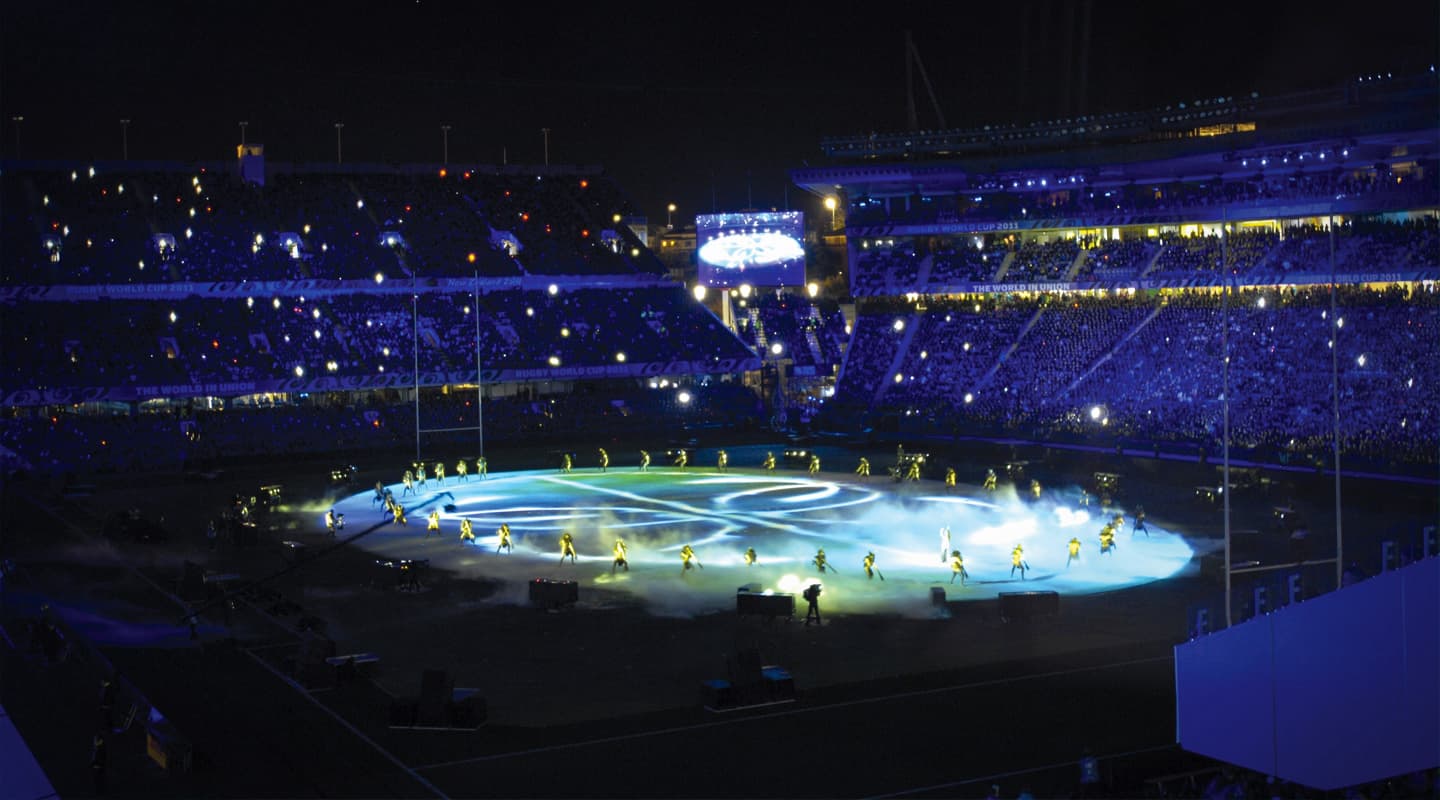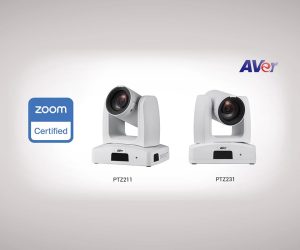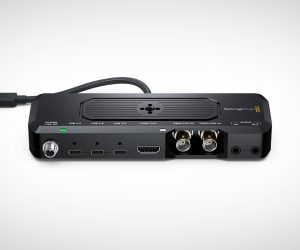
Try, Try & Try Again
The view from the control room at the Rugby World Cup opening ceremony.
Text:/ Paul Collison
The opening ceremony to any sporting event is an opportunity for the host nation to show an international audience the culture and essence of the local community, while bringing some sort of humanity and identity to the event. No matter how big or small, the opening ceremony sets the tone for the weeks to come.
The opening ceremony of the 2011 Rugby World Cup in Auckland New Zealand did just that. Broadcast to a worldwide audience of over one billion, despite being largely snubbed by the Australian media, the ceremony was a short, sharp and precise cultural display that many New Zealanders were proud of, and more importantly, made the rest of the world sit up and take notice.
After a lengthy tender process, David Atkins Enterprises of Sydney were announced producers of the event. DAE immediately expanded its New Zealand operation to include a healthy balance of local talent and ceremonies-experienced international team. Creatively headed by David Atkins himself, the ceremony had to be designed around some utterly non-negotiable parameters.
HOLY GROUND
Firstly, whatever the ceremony was to entail, the protection of the playing surface was of the utmost importance. No matter how spectacular a production design might have been, if it were to have a detrimental affect on the playing surface, it was instantly discarded.
The second parameter that weighed heavily on the design team was the requirement that the playing field had to be cleared within 10 minutes of the conclusion of the ceremony, for the opening game to start a short time later. Of course there were a thousand other challenges facing the design team, including limited finances, resources and space. However, the two principle issues of the playing surface and clearing the field of play quickly were constantly at the forefront of everyone’s minds.
Enter the projection surface. What better way to tell a story and protect the playing surface than with a projection surface on the field. The surface was made from standard shade cloth, stitched together into straight sections and then painted to leave an oval projection zone in the centre of the field. Shade cloth was the ideal material as it let rainwater penetrate through to the grass rather than pooling and causing headaches for the ground cloth crew. It also didn’t suffocate the grass underneath during the eight or so hours it was out for each day/night. This approach is nothing new. In 2003, for the opening of the Rugby World Cup in Sydney, a projection surface on the field of play worked with the PIGI projection from The Electric Canvas.
Fast forward eight years to 2011, and The Electric Canvas, still headed by Peter Milne, is using 32 Christie Roadster S+20K projectors to similar effect. Although the advantages of video projection over PIGI scrolling projection are abundantly clear, the reduced light output of video projection remains an issue. Despite 32 projectors, quad-stacked on eight footprints, the light level on the projection surface hovered around 150 to 180 lux. This is quite low considering that under the stadium sports lights the level is around 3000 lux! While modern HD camera systems can deal with the lower light level, other factors had to then be considered including ambient light spill from concessions, basic egress lighting in the stands and the actual lighting of performers interacting with the projections. A careful balance of lighting and projection had to be evolved for the ceremony to be successful.

PROJECTION RULES
Enter the lighting department. It was critical to strike that perfect balance between lighting the show and not disrupting the projection on the field of play. The base light level was dictated by the projection. Any and all other lighting had to balance to that. The outside broadcast cameras were essentially wide open for the duration of the performance. The resulting limited depth of field may have given the camera operators a hard time in holding focus, however, it did mean that the basis of the show, the projection, would always be prominent in shots.
Lighting performers and set pieces on the field was no easy task. Direct light from an elevated position was less than ideal, as this of course would wash out the projection. A combination of side light from the periphery of the performance space and tight integration with the image content was the only viable solution.
ARK LIGHTING
A modest 60 x Martin Mac 2000 profiles were deployed in groups of three around the performance space. Compare this number with the 180 used for a similar surface area for the 2006 Commonwealth Games opening, and you’ll begin to appreciate the challenge. Those 60 fixtures actually lit 90% of the broadcast. Meanwhile, 82 x Mac 2000 washlights covered most of the audience to fill out the background of the low-angle field shots.
We also can’t forget the 16 x High End Cyberlight Turbos (that Noah generously donated from his ark for the event). On the odd occasion they returned to their pre-recorded positions, they did a stellar job in lighting various tableaux and protocol moments.
The integration of lighting and projection under these conditions was indeed problematic. At times where it was impossible to light a performer for various reasons, windows and highlights could be built to create areas in the projected image where a performer, or a group of performers, could be visually enhanced. John Baxter of Perceptual Engineering in Auckland was responsible for building the media content for the show. His desire to not only build the content with animation, but also include organically-captured video, helped legitimise the content and make some of the packages quite realistic. Working on a modest budget, the animation team did an amazing job collaborating with Michael Reid of DAENZ to deliver some beautiful content.

TOTAL CONTROL
The co-ordination with other departments did not stop at the technical level. It was imperative that the choreography of the performers was within the limits of what could physically be lit at one time. Due to the side-lit nature of the show, mass cast movements had to be carefully placed. Performers could easily mask light intended for another. Entrances and exits of mass cast also had to be precisely choreographed, with many hours of rehearsal time spent considering this.
Driving the video side of things was the Onlyview video replay system from ETC of London and Paris. Onlyview is a distributed video control solution that The Electric Canvas have used on many events around the world. It is at the core of all their video projection events largely because of the flexibility and redundancy it provides.
The central video control area housed the main ‘Producer’ controller from which the show was programmed and run. Server clusters were then located on the Eastern and Western roof positions, not far from the projectors themselves. Redundant Producer stations receiving timecode were located and manned in those areas, ready to take control should the network go down and local control be required.
WHISTLING IN THE DARK
From an audio perspective, the challenges were just as great. Audio designer Scott Willsallen, from Auditoria, points out “Eden Park Stadium was a very difficult venue, both architecturally and in terms of getting access to the field of play to deploy the loudspeaker system and conduct system tuning. In fact, the only time we heard the audio system at full show level was during the show itself. This situation required days of modelling and calculations, as well as a great deal of previous experience with the loudspeaker system to arrive at the final tuning.”
Musically, the ceremony was spectacular, drawing from the rich musical traditions from all parts of New Zealand and combining traditional instruments and sounds with contemporary music to produce a show that was dynamic, powerful and enveloping.
It was clear from the beginning of the design process that the loudspeaker system would need to deliver high sound pressure level and full bandwidth to every seat in the 80,000 capacity stadium. The system consisted of 18 arrays distributed around the edge of the field of play. One array was located in each corner, three across each end and four along each side of the field. Each array consisted of five L-Acoustics Kudo line-source elements and two EAW BH760 horn-loaded subwoofers plus monitor speakers for the cast.
The audio control system was a 100% dual-redundant design with a primary digital network using Optocore hardware teamed with an analogue backup network. Two Digico SD8 consoles were used for mixing FOH and monitors, again in a dual-redundant configuration. A pair of Pyramix 48-channel replay systems driven by an Isis remote controller delivered the music stems to the mixing consoles and to the host broadcaster. A custom dual-redundant Rode lectern microphone system was used to capture the speeches.
HEAVY LIFTING
The available live load capacity and the geometry of Eden Park Stadium structure did not allow for a suspended audio design or copious quantities of lighting fixtures in the roof. Thus the audio system in its entirety, along with a bulk of the lighting equipment and some special effects (some 20 tonnes all up) had to be co-located on the field. Under the expert direction of Nick Newey, Ian Baldwin and Alistair Cameron, most of this equipment was installed and removed each day for around two weeks prior to the show.
In an amazing display of teamwork and planning, all equipment including the ground cloth was removed from the field of play in less than nine minutes at the conclusion of the show – allowing the New Zealand and Somoan rugby teams to get on with task of playing an actual game of football.
PRODUCTION CREDITS
David Atkins Enterprises
Creative producer: David Atkins
Executive producer: Merryn Huges
Producer: Michael Reid
Technical director: Nick Newey
Lighting designer: Paul Collison (Eleven Design)
Audio designer: Scott Willsallen (Auditoria)
Technical manager systems: Ian Baldwin
Technical manager: Alistair Cameron
Lighting – Oceania Norwest with Spot-Light Systems
Account manager: Simon Garret
Project managers: Jeremy Fern & Alex Oldham
Programmer: Jason Fripp
Video projection –The Electric Canvas
Project manager: Peter Milne
Sound – Oceania Norwest
Project manager: Andrew Rodd
Systems engineer: Justin Arthur
Replay engineer: Trevor Beck
Audio operator: Ian Shapcott















RESPONSES